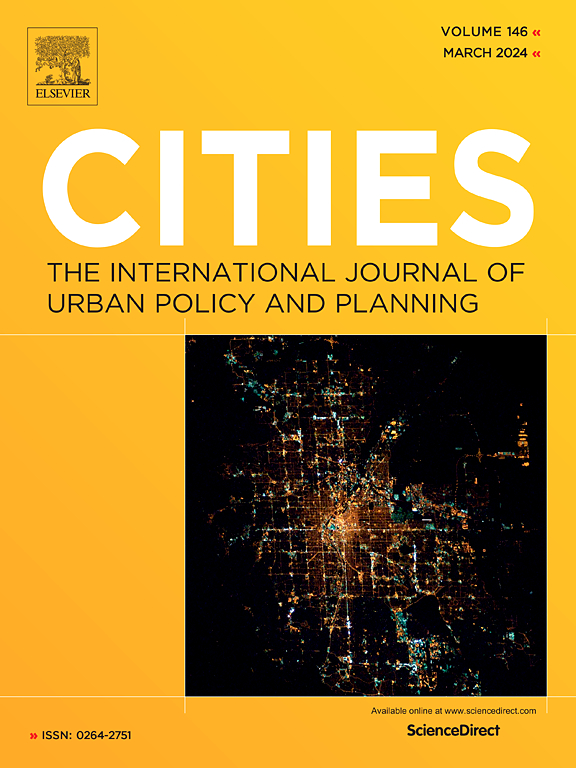Research on the relationship between urban space and ecological environment evolution at the grid scale: a case study of Lanzhou City
IF 6
1区 经济学
Q1 URBAN STUDIES
引用次数: 0
Abstract
The evolution of urban space from “Urban Sprawl” to “Smart Growth Policy” and further to “Green Infrastructure” underscores the pressing need to establish a precise and quantitative research framework for analyzing the relationship between urban space and ecological environment evolution. This serves as a crucial foundation for enriching theories and practices in urban intelligent management. Taking Lanzhou City as a case study, this paper employed a relatively novel research idea to analyze the dynamics between urban space and ecological environment evolution. The results indicated a growing trend in the scale and intensity of urban expansion in Lanzhou City from 1995 to 2020, accompanied by a decrease in urban landscape fragmentation. The urban expansion is primarily concentrated in the western and northern regions, with its spatial pattern shifting from a cluster-based horizontal expansion to a leapfrog development model. Over the same period, the Urban Space Ecological Risk Index (ERI) and Land Surface Temperature (LST) in Lanzhou City exhibited an upward trend, with a weakening trend observed in the peripheral urban areas. Overall, the distribution pattern is characterized by “higher in the north and lower in the south”. While there was a marginal increase in the Ecosystem Service Value (ESV) in localized urban areas, a more pronounced improvement was evident in the urban periphery. Urban spatial ecological pressures were on the rise, indicating a deteriorating ecological environment. Nevertheless, human responsiveness to these environmental challenges is progressively improving. Positive correlations were observed between Impervious Surfaces Percentage (ISP) and ERI and LST, while a negative correlation existed with ESV. Lanzhou City's urban space necessitates a shift towards smarter growth in the northern direction and the augmentation of green infrastructure. This study offers novel perspectives, ideas and methodologies, for scholars, while also providing scientific references for urban planning, management, renewal, and ecological restoration.
网格尺度下城市空间与生态环境演化关系研究——以兰州市为例
从“城市蔓延”到“智慧增长政策”再到“绿色基础设施”的城市空间演变,迫切需要建立一个精确、定量的研究框架来分析城市空间与生态环境演变的关系。这为丰富城市智慧管理的理论和实践奠定了重要基础。本文以兰州市为例,采用较为新颖的研究思路,分析了城市空间与生态环境演化的动态关系。结果表明:1995 ~ 2020年兰州市城市扩张规模和强度呈增长趋势,城市景观破碎化程度呈下降趋势;城市扩张主要集中在西部和北部地区,空间格局由以集群为基础的横向扩张向跨越式发展转变。同期,兰州市城市空间生态风险指数(ERI)和地表温度(LST)呈上升趋势,外围城区呈减弱趋势。总体上呈“北高南低”的分布格局。城市局地生态系统服务价值(ESV)略有增加,而城市外围生态系统服务价值的改善更为明显。城市空间生态压力加大,生态环境恶化。然而,人类对这些环境挑战的反应正在逐步改善。不透水面百分率(ISP)与ERI、LST呈显著正相关,与ESV呈显著负相关。兰州市的城市空间需要向北部方向的智能增长转变,并增加绿色基础设施。本研究为学者提供了新的视角、思路和方法,同时也为城市规划、管理、更新和生态修复提供了科学参考。
本文章由计算机程序翻译,如有差异,请以英文原文为准。
求助全文
约1分钟内获得全文
求助全文
来源期刊

Cities
URBAN STUDIES-
CiteScore
11.20
自引率
9.00%
发文量
517
期刊介绍:
Cities offers a comprehensive range of articles on all aspects of urban policy. It provides an international and interdisciplinary platform for the exchange of ideas and information between urban planners and policy makers from national and local government, non-government organizations, academia and consultancy. The primary aims of the journal are to analyse and assess past and present urban development and management as a reflection of effective, ineffective and non-existent planning policies; and the promotion of the implementation of appropriate urban policies in both the developed and the developing world.
 求助内容:
求助内容: 应助结果提醒方式:
应助结果提醒方式:


